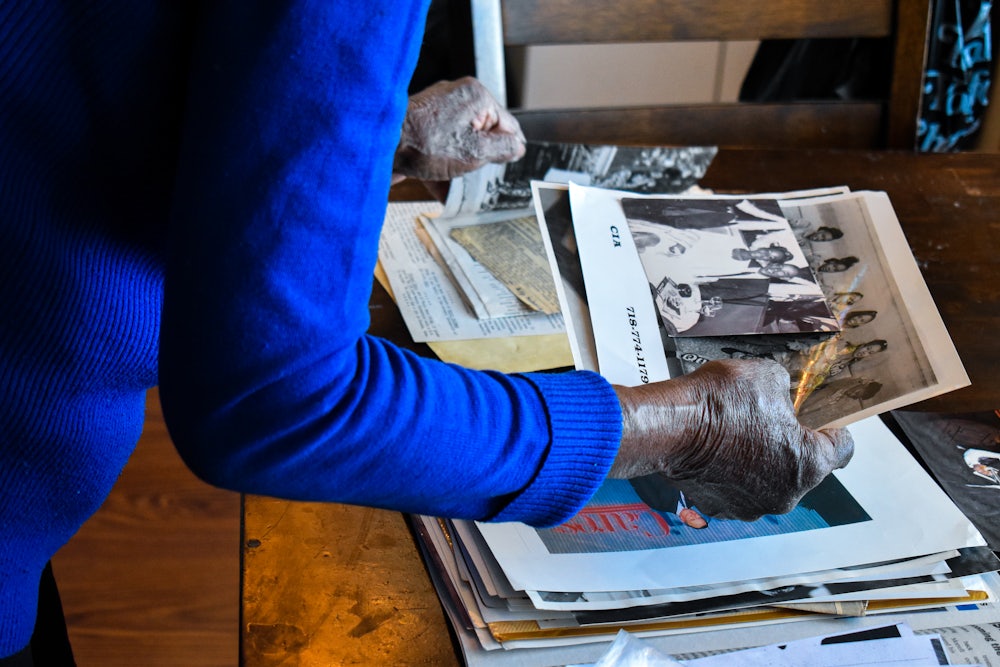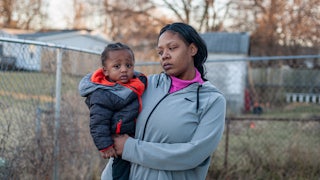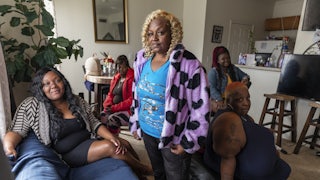Eula May McNair, age 82, sits on her couch, sifting through yellowed newspaper clippings; Polaroid prints of her days touring Europe with The Tiffanies, a three-woman singing group; and certificates awarded to her daughters, whom she brags about with motherly ease. She picks up a photo: “Me and my husband down at the Copacabana,” Eula says, smiling. “Everybody thought I was a movie star. Ain’t that something?”
These photos are the ones that survived the three floods Eula has endured in the last two years alone. She’s lived in Harlem’s Esplanade Gardens for about four decades—raising children and grandchildren and hosting what she termed several lively parties.
Opened in 1967, Esplanade Gardens’ co-op apartments were birthed out of the Mitchell-Lama housing program—a 1950s equity initiative to increase home ownership among middle-income New Yorkers. Across the city, the program was seen as a way for Black families to acquire intergenerational wealth and gnaw away at centuries-long inequality in housing.
Then it started falling apart. On that same nostalgia-filled, cold February morning, Eula walked me through each room in her top-floor apartment, pointing to walls that were torn down, pipes that had burst, and floors that were patched with duct tape. “This whole place is not good,” she said, “and it’s making people sick.”
Eula is one of dozens of Esplanade residents I’ve met with similar experiences. They say their living experiences have diminished rapidly over the past few years, when upkeep of Esplanade Gardens was taken over by Metro Management Development, Inc., a real estate company that manages over 35,000 apartments around New York City and Long Island, including several Mitchell-Lama buildings. Metro took over from Prestige Management, under whose stewardship there were also documented cases of complaints at Esplanade. On Metro’s website, the company boasts, “We strive to insure that every property we manage and every client we represent receives our finest efforts.” (Metro Management did not respond to multiple messages left with its office.)
The residents I spoke to tell another story, one of a mammoth, multimillion-dollar renovation project taken on by new management that has upended lives. One that began as an attempt to revamp and improve the complex but has culminated in a housing crisis.
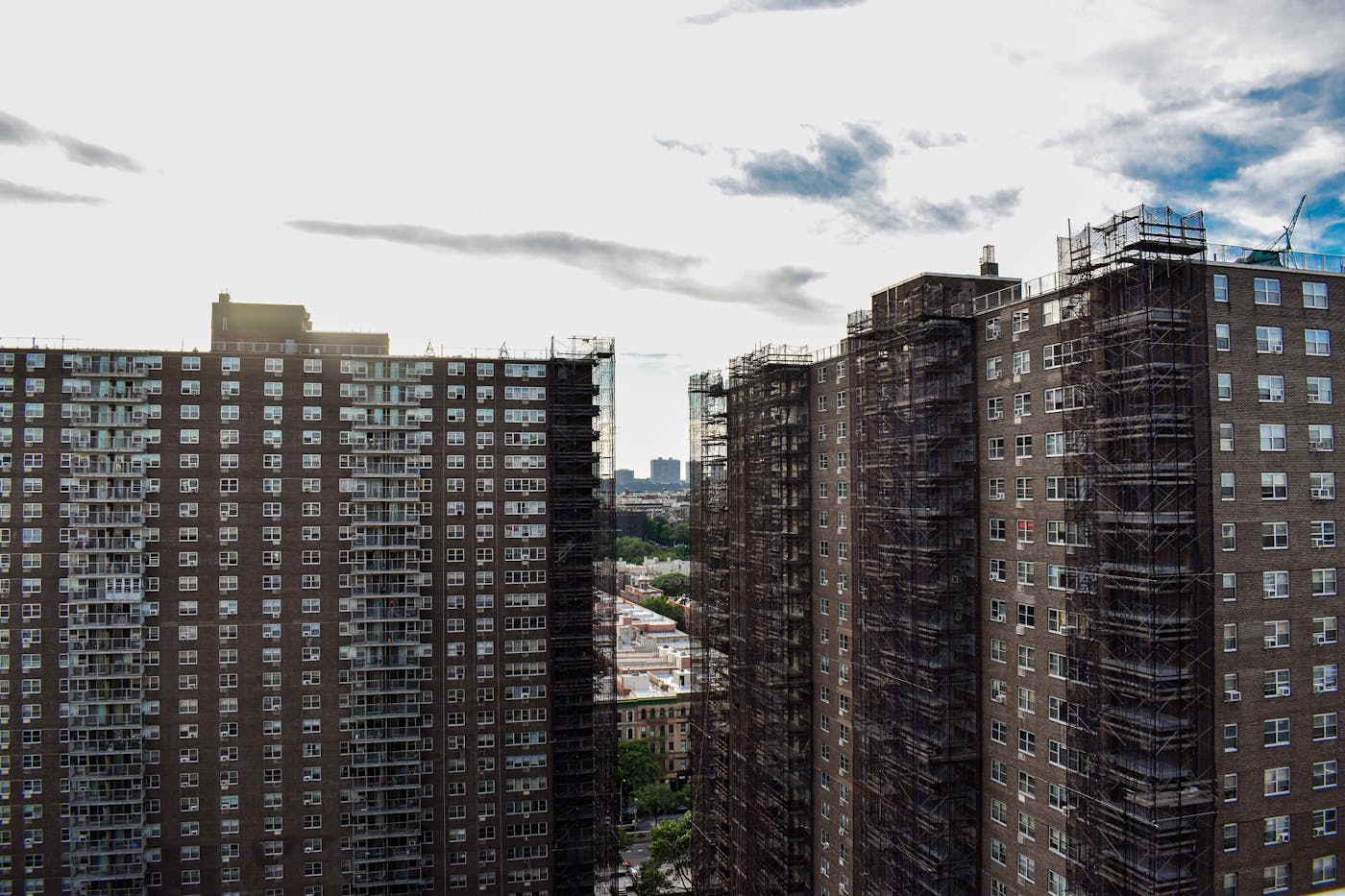
The six-building, 1,872-unit complex is over 50 years old and has received little maintenance over the decades. At the same time, as a middle-income affordable housing program, Esplanade Gardens has operated at a financial deficit at times, pulling from a shallow pool of residents’ monthly fees for issues with immense depth. Because Esplanade shareholders (the name co-op apartment owners use to describe themselves) own their apartments and hold equity in the shared housing corporation, responsibility is complicated—the trinary control by Esplanade Gardens Board of Directors (elected by residents), the hired outside management company, and the city’s housing agency leaves everyone pointing fingers and residents hanging in the balance. Then the invasive, often poorly executed capital improvement project starts—old structural negligence is laid bare, there’s a lack of accountability, and shareholders’ apartments are caught in the mix.
What’s more, Esplanade Gardens has a large population of elderly and Black residents, existing at an intersection particularly vulnerable to the lack of care in Harlem, New York City, and the United States for aging populations. They live at the epicenter of what happens when once grand programs made to transform inequities in housing are left to wither as time passes, hurting those they were meant to benefit along the way.
When Eula and I talked weeks before my visit to her apartment, we discussed fear of what may happen if these construction projects continue unfettered and how she and her neighbors don’t want to end up as the next headline.
Eula lives about three miles away from Twin Parks North West, the 19-story Bronx apartment building where a five-alarm fire left 17 people dead in January. The fire, which garnered national attention and challenged new Mayor Eric Adams’s leadership, illustrated what happens when residents’ concerns are ignored by those in power. Data shows that Bronx residents submitted complaints about lack of heat (a space heater started the blaze), lack of ventilation, and poor sanitary conditions. In several instances, the New York City Department of Housing Preservation and Development “inspected conditions and did not issue a violation.”
Residents and housing advocates alike have criticized local government, the media, and the building management for only showing up once their lives were lost, their homes destroyed, and their community reeling—caring too little, too late, and not investing in their stories prior to the onset of tragedy. Bola Omotosho, a Bronx resident and the head of Community Board 5, told Gothamist, “When the cameras are out, that’s when the folks need help most.”
In January, the survivors of the Bronx fire and victims’ families filed five lawsuits against the building owners for neglect, hoping to hold those who let violations pile up to some level of accountability. Yet this doesn’t change the pain and lifelong trauma inflicted upon these primarily Black and immigrant New Yorkers.
Residents at Esplanade Gardens watched the Bronx fire in horror—empathizing with those living conditions and fearing that their building may be the next to crumble. Esplanade residents see themselves in the post-tragedy reporting, too, because they’ve been filing complaints and sounding alarms for years about their dangerous living conditions. In the past two years, co-op owners have called 311 hundreds of times, including in dozens of instances of fire-related concerns like lack of heat, door and window issues, and electrical problems. Residents also recount flooding so intense it spills out into the hallways, or flows down the stairs, or disrupts elevator use, potentially making viable emergency exits inaccessible. Following the Bronx fire, workers went around Esplanade to check if front doors were able to close, but Eula says they didn’t examine other aspects within her unit that could also trigger fires.
Moiré Davis has lived in Esplanade Gardens for 18 years and been the board president about five. She is tasked with making a lot of the technical decisions in the building, overseeing the day-to-day at the complex. She has become a kind of controversial figure, with some residents claiming Moiré can be dismissive or resentful. Some have even crafted petitions to remove her from the board.
She answered quickly when I asked if she enjoys the job. “No,” she began, “being the board president is very stressful. It’s a thankless job.” But, she continued, “I enjoy trying to make a positive change and difference in my community.” Moiré has coordinated food drives for seniors, spoken up about gentrification in the neighborhood, and is a community leader often in meetings with local government and advocates.
She admitted that there have been problems with the capital improvement project and noted that some residents have had very difficult circumstances to deal with. “We need to work together and not apart,” she urges.
Esplanade Gardens wasn’t always like this, a collection of controversy and capital fights. In the summer of 1970, residents dubbed the complex “the best housing buy in the city.”
With a $40 million price tag, the complex was built on abandoned Transit Authority yards off 147th Street and lauded by then-Mayor Robert F. Wagner Jr. for adding much-needed affordable housing for Harlem’s middle class. Residents were proud to be a part of this project for Upper Manhattan—an epicenter of Black art and resistance. A newsletter from the time describes a gala in building three, where residents danced “beneath a waving sea of colorful balloons” and “a good time was had by all.” Per local reporting, in 1965, a New York–based radio station described the new construction project as “the Jewel of Harlem,” and the name stuck.
When longtime residents Gloria Lowe and Millicent Redick walked me around the property last summer, displaying their own unlivable conditions and introducing me to other residents with similar problems, they too called Esplanade Gardens “the Crown Jewel of Harlem,” and then laughed.
Gloria’s top-floor apartment, which she has lived in for 47 years, is filled with hand-picked art, a striking chandelier, and, on the kitchen table, dozens of legal documents and photographs detailing her correspondence with management, the board, and the city over the past couple of years. The pictures show the aftereffects of multiple floods, damaged property, and bashed-in walls; the documents show insurance claims, court judgments, and letters with five-figure solutions for her problems. “I’ve been through some hell. I can’t tell you,” Gloria said. “I’m not the only one though; people have been through hell here. This has not been an easy journey.”
While shareholders pay a maintenance fee that, in part, provides a super to fix problems in their units, they own their apartments. The renovation project was geared toward the deteriorating conditions in shared spaces—the pipes in the walls, the hallways, the outdoor facades—that are handled by the building’s management. And while capital improvements to those sections of the building should theoretically be separate from the interior of residents’ units, this hasn’t been the case. Instead, the project is deeply invasive, impacting floors, walls, ceilings, personal property, and, often, the entire home.
Protruding from Gloria’s entryway there’s now a pipe that she must duck to walk beneath. She is used to being inconvenienced in the name of alleged apartment updates. Earlier last year, Gloria requested a transfer to another unit, for urgent health reasons. (Residents are allowed to switch units for nonemergency reasons, like needing an extra bedroom, but that is a separate process involving cost comparisons and equity transfers.) Management replied that they had a transfer available, but the cost for the new apartment would likely be between $28,000 and $35,000. This was a nonoption for Gloria.
As we left Gloria’s building, walking under construction scaffolding that all but shaded the sun, we ran into residents petitioning about the deteriorating conditions.
Once people at Esplanade begin to speak of the issues with their apartments, the conversation doesn’t cease. Shareholders bounced back and forth with anecdotes of everything from lack of cleaning after construction to entire sections of ceilings collapsing. When bathroom piping was replaced, multiple residents were left without toilets and working showers, forced to wash themselves in sinks and use a communal bathroom downstairs or temporary toilets in their living rooms. When communal spaces were altered, shareholders lost vital public resources that they depend on, like a playground, benches used by the elderly community, and an outdoor pool. When there was drilling through ceilings and walls, creating holes leading directly to the outside, people were left vulnerable to harsh winter chills and, similarly, with A.C. units blocked by construction materials, residents faced intense summer heat. Flooded basement storage. Blocked mailboxes. Concrete-filled tubs.
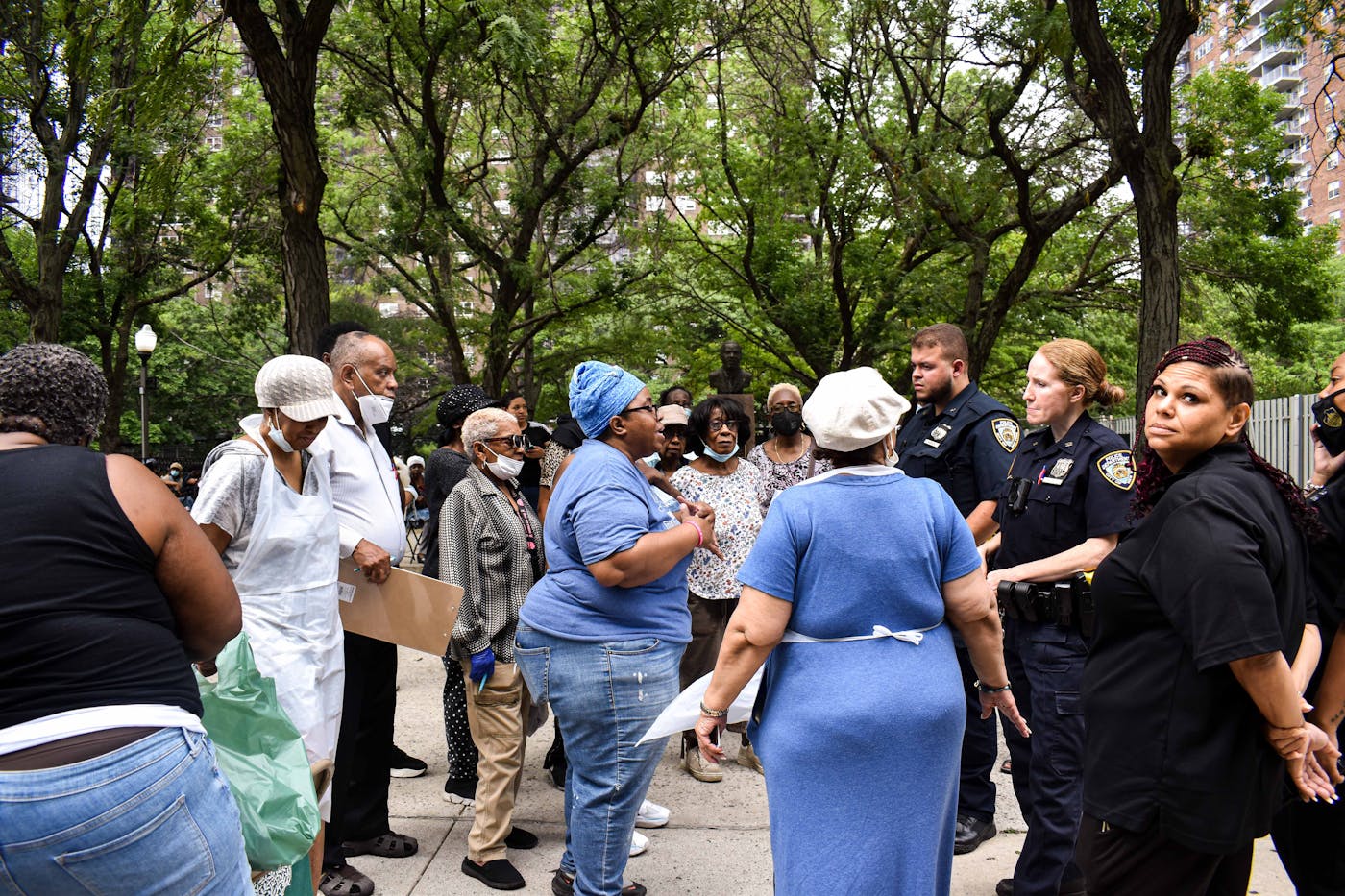
When residents attempted to publicly protest the conditions in July, holding a bake sale for legal fees accrued through disputes, management security brought over the New York City Police Department. The police quickly left, finding the dozens of primarily Black women selling cake on the sidewalk not to be in violation. Still, the fact that the cops were summoned shows how far the relationship has deteriorated between some residents and the board and its management company.
I was initially introduced to Esplanade’s troubles via Millicent’s story. Millicent seems like the kind of person who knows all of her neighbors by name, because she does, after living in the building since 1968. On January 20, 2021, her neighbor called her while she was on vacation, informing her that her apartment had flooded. Forced to tend to the emergency, Millicent came back to a home—where, just a couple years earlier, she had updated the kitchen, redone the floors, repainted walls, and purchased new furniture—now rendered uninhabitable. Over the next few months, she would realize that the apartment was deeply infected with mold, requiring ceiling replacement and chemical treatment on all her possessions.
As she let me in the door, both of us masked and trying to avoid breathing in the contaminated air, her energy dropped. Silence hung in the room as Millicent combed through mementos covered in some sort of substance, a seemingly unidentifiable composite of dust, paint, plaster, and mold. When she did speak, it was short. “I can’t do anything,” she said, “I had to walk away from everything.” In the bathroom, toothbrushes, unused for months, looked eerie next to the erupting ceiling above the toilet—under which sat a dirtied childhood photo, the glass now opaque.

Management, she says, told her to remove all of her property before any work could be done. At 77 years old, she was unable to transport her belongings by herself, and didn’t feel comfortable having her younger family members spend extended periods of time in a toxic environment.
In the year since the flooding she has spent around $3,000 on specialty movers and $2,000 to treat her mold-infested essentials, in addition to the thousands she paid on routine monthly maintenance fees before the building paused her payments, the $165 she is paying for a storage unit each month, and the accumulating cost of driving from different locations to check on the apartment. “I’m living out of my car almost,” she told me, jumping between family members’ homes as workers’ timelines change daily.
Black residents’ experiences at Esplanade Gardens are mirrored locally, across New York City, and nationally.
A 2019 study focused on Central Harlem, where the complex is located, found that aging in place is particularly hard for older Black residents in gentrifying communities. Researchers noted that “gentrification may increase the invisibility of aging adults by contributing to indirect and direct processes that erase people and places of significance.” The researchers highlight how overlapping changes—financial, cultural, interpersonal—work to devalue an entire generation of Harlem’s Black residents.
“In this way,” they write, “Harlem is not simply a neighborhood, it is an example of Black placemaking, evidenced by participants’ reflections of how residents were able to transform what others deemed as disorder into authentic experiences, community, and spaces of inclusion and celebration.”
New York State Representative Al Taylor, who both represents residents at and is a commercial tenant of Esplanade, has called on the city to take more responsibility. “Residents have a reason to be upset,” Taylor wrote last fall.
Around the city, older Black New Yorkers are less likely to own their homes than their white counterparts, and homeownership is a well-documented tool for transferring wealth to future generations. Esplanade shareholders told me that dreams of passing along their apartments to children and grandchildren get grimmer by the day, as they are forced to choose between selling for their personal health and weathering the capital improvements in hopes of better days.
The Mitchell-Lama program that birthed Esplanade still exists. But since its introduction in the 1950s, the city has transitioned the way it thinks and provides affordable housing to middle-income communities. For decades, those in power in New York have shifted from developing, dedicating, and filling entire buildings only with middle-income residents to the model the city has now: earmarking a percentage of units in new developments for low and moderate earners.
The earmarking technique keeps developers’ pockets full and accessible housing availability slim, said Kavita Kulkarni, a researcher at Princeton who has written on affective economies of race and housing in NYC. Kulkarni noted that these programs exist inside a larger ecosystem, and “to put the preservation of affordable housing on these residents, I don’t think that’s right.” Part of the issue may be the pure size of Esplanade, said Kulkarni, who has researched smaller Mitchell-Lamas. “The idea that a single board of directors can adequately and efficiently govern a complex of 1,800-plus units seems a bit pie in the sky.”
Nationwide, hundreds of thousands of public housing units have been demolished since the 1990s. Each year, some 10,000 units are lost to decay, with the capital project backlog for existing buildings growing by more than $3 billion a year, per 2018 reporting in Mother Jones. From Nixon declaring a moratorium on housing spending in 1973 to Reagan slashing operating funds in the 1980s to Clinton signing an emergency spending bill with a $2.3 billion cut to a program for low-income tenants in May 1998, public housing in the U.S. has been fighting an uphill battle for decades.
The local shift in housing infrastructure across the city and the national assault on public funding has culminated in a labyrinthine relationship between NYC’s housing department and the residents of Mitchell-Lama buildings. Even in my call with the New York City Department of Housing Preservation and Development, the conversation was filled with clarifications and uncertainties about what the agency would, or could, do. While HPD is not Esplanade’s landlord, it does dictate certain rules and regulations, oversees the program, and operates a phone number that provides assistance for people looking to apply to Mitchell-Lama buildings.
For Bakry Elmedni, a professor at Long Island University Brooklyn, this decades-long shift away from dedicated middle-income buildings across the city is hurting the very groups Mitchell-Lama was made to serve. “There is no doubt by any statistics the losers in all of this would be people of color,” he said. The creators of Mitchell-Lama, Elmedni told me, lacked foresight, effectively telling shareholders, “Enjoy success now and deal with whatever challenges as you go down the road.”
In Eula May McNair’s apartment, we oscillate between stories of having her daughters’ friends fill her living room and her grandchildren fill the extra bedroom—which now sits empty because she feared for their health during the capital projects. She used to be a receptionist for an apartment complex just down the road, which she brings up when frustrated about how the office at Esplanade treats residents. Then Eula hands me a four-decades-old newspaper clipping highlighting this work, describing her as “a person with tremendous energy and, at the same time, a high degree of patience, tolerance, and understanding.” It still fits her to a tee. Except, she’s running out of patience.
For months, Eula has been losing weight. She told her doctor it was the mold from the apartment floods and, doubting her, he completed a litany of other tests. It isn’t cancer. It isn’t this, or that. She’s informed management, and yet her floors sit unchanged, never recovered from the flow from bursting pipes that ravaged her home. Eula, who used to be around 160 pounds and now sits at about 120, says she keeps eating, hasn’t changed anything about her routine, and wakes up feeling sicker and sicker each day.
“People who live here suffer,” Eula said. “Why do I got to suffer?”
